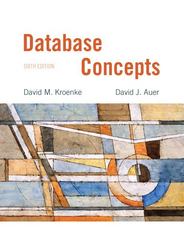Question
You are given an array A of N integers, and an integer X. For each K in the range [1,N], determine the number of ways
You are given an array A of N integers, and an integer X. For each K in the range [1,N], determine the number of ways to partition the array into exactly K non-empty subarrays such that the maxima of each of the subarrays are at least X.
The number of ways can be large, so output it modulo 998244353.
Note: The input and output are large, so use fast input-output methods.
Input Format The first line of input contains a single integer T, denoting the number of test cases. The description of T test cases follows. Each test case contains two lines of input. The first line of each test case consists of two space-separated integers N and X. The second line consists of N space-separated integers denoting the elements of the array A. Output Format For each test case, output a single line containing N space-separated integers, the i-th of which denotes the number of ways to partition the array into exactly i non-empty subarrays such that the maxima of each of the i subarrays are at least X. Print the answer modulo 998244353.
Constraints 1T7104 1N106 1X109 1Ai109 The sum of N across all test cases does not exceed 106 Subtasks Subtask #1 (20 points):
1T200 1N103 The sum of N across all test cases does not exceed 2103 Time Limit = 1 second Subtask #2 (80 points):
Original constraints Time Limit = 1.75 seconds Sample Input 1 3 5 3 4 1 7 1 6 4 2 2 2 2 1 3 4 5 6 7 Sample Output 1 1 4 4 0 0 1 2 1 0 1 2 1 Explanation In the below explanation, [L,R] denotes the subarray consisting of elements AL,AL+1,,AR.
Test case 1:
The number of partitions having exactly 1 subarray is 1, which is the array itself. The number of partitions having exactly 2 subarrays is 4, which are [1,1]+[2,5], [1,2]+[3,5], [1,3]+[4,5], [1,4]+[5,5]. The number of partitions having exactly 3 subarrays is 4, which are [1,1]+[2,3]+[4,5], [1,1]+[2,4]+[5,5], [1,2]+[3,3]+[4,5], [1,2]+[3,4]+[5,5]. The number of partitions having 4 or 5 subarrays is 0. Test case 2:
The number of partitions having exactly 1 subarray is 1, which is the array itself. The number of partitions having exactly 2 subarrays is 2, which are [1,1]+[2,4], [1,2]+[3,4]. The number of partitions having exactly 3 subarrays is 1, which is [1,1]+[2,2]+[3,4]. The number of partitions having exactly 4 subarrays is 0. Test Case 3:
The number of partitions having exactly 1 subarray is 1, which is the array itself. The number of partitions having exactly 2 subarrays is 2, which are [1,1]+[2,3], [1,2]+[3,3]. The number of partitions having exactly 3 subarrays is 1, which is [1,1]+[2,2]+[3,3].
Step by Step Solution
There are 3 Steps involved in it
Step: 1

Get Instant Access to Expert-Tailored Solutions
See step-by-step solutions with expert insights and AI powered tools for academic success
Step: 2

Step: 3

Ace Your Homework with AI
Get the answers you need in no time with our AI-driven, step-by-step assistance
Get Started


